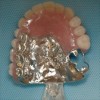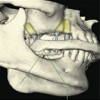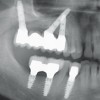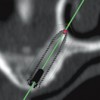Children with craniofacial anomalies and developmental deformities often present with missing dentition. Other children suffer from traumatic episodes that result in the loss of a portion of the dentition. Therefore several questions arise. Should implants be placed in growing children? If so which children? If consideration is given to placing implants in children, at what age should they be placed. This program addresses these questions in specific terms and provides useful insights when considering implants in this group of patients.
Dental Implants in Growing Children — Course Transcript
- 1. 13. Implants in Young Children and Adolescents Arun Sharma DDS Department of Preventive and Restorative Dentistry UCSF School of Dentistry John Beumer III DDS, MS Division of Advanced Prosthodontics, Biomaterials and Hospital Dentistry UCLA School of Dentistry This program of instruction is protected by copyright ©. No portion of this program of instruction may be reproduced, recorded or transferred by any means electronic, digital, photographic, mechanical etc., or by any information storage or retrieval system, without prior permission.
- 2. Objectives! Present some guidelines for implant therapy in children
- 3. Issues! Should Implants should be placed in children?! If so, which patients?! At what age should implants be placed?
- 4. Implants in Young Children and AdolescentsOur Primary Concern with Implant Placement is Growth! The newborn lacks pronounced alveolar ridges! Maxillary vertical development comes with developing tooth buds and the formation and eruption of teeth! The maxilla comes down and forward secondary to sutural apposition and with downward and forward growth of the alveolar process associated with the eruption of primary and permanent teeth! Growth of the mandible is not dependent on the presence of teeth
- 5. Implants in Young Children and AdolescentsGrowth ! Inthe absence of maxillary teeth the alveolar ridges do not develop and the maxilla will be underdeveloped sagitally and vertically ! Mandibular growth is not dependent on the presence of teeth ! Therefore, in the presence of anadontia or hypodontia the relationship between the maxilla and mandible is disproportionate with most patients developing Class III relationships
- 6. Implants in Young Children and AdolescentsGrowth ! Implants do not change position with growth and do not move vertically with alveolar development (Odman et al, 1991, Sharma and Vargervik , 2006) ! Implants placed in the anterior portions of the maxilla and mandible do not affect transverse growth of these structures (Thilander et al, 1992)
- 7. Partial or Complete Anadontia Patient Classification (Sharma and Vargervik, 2006)! Group I – Children congenitally missing one tooth with adjacent permanent teeth! Group II – Children missing multiple teeth but with permanent teeth adjacent to edentulous sites! Group III – Children who are completely edentulous in one arch or have one or two teeth in undesirable positions
- 8. Group I – Children congenitally missing one tooth with adjacent permanent teethCleft lip and palate patients with single tooth defects secondary to partial anadontia Cleft Partial Anadontia Partial Anadontia
- 9. Group I – Children congenitally missing one tooth with adjacent permanent teeth Dentition in Cleft Patients ! Missing Lateral Incisors – 40% ! Supernumerary Lateral Incisors– 7% ! Hypodontia – 50%
- 10. Group I – Children congenitally missing one tooth with adjacent permanent teeth Management of the Missing Lateral Incisor in CleftsImplants – Issues ! Growth – Skeletal Development ! Dental alveolar ! Mandible and maxilla ! It is advisable to wait until two consecutive cephalometric films one year apart show no evidence of growth ! Site development ! Horizontal and vertical deficiencies usually present Courtesy A Sharma
- 11. Group I – Children congenitally missing one tooth with adjacent permanent teethNote: Gingivalcontours are notquite normalWhy?Scarring Courtesy A Sharmaassociated withthe closure andgrafting the cleft Consequences: None. Almost all cleft patients have a low smile line.
- 12. Group I – Children congenitally missing one tooth with adjacent permanent teeth Management of the Missing Lateral Incisor in CleftsImplants – Issues ! Consequences of early placement ! Implant will be submerged relative to the adjacent teeth with the attendant esthetic consequences ! Less favorable implant biomechanics ie. crown root ratios Courtesy A Sharma
- 13. Note gingival contours. These are to beexpected given the scarring secondary tothe multiple surgical procedures necessaryto close and graft the cleft. UCSF Data (Sharma and Vargervik, 2006) Courtesy A Sharma! 24 patients (15 male, 9 female) ! 33 implants placed! 9 bilateral clefts ! 31 implants restored! 15 unilateral clefts ! 28 still in function
- 14. Grafting the Cleft and Placing the Implants Average age in years! Alveolar cleft bone graft – 14.3 ! Range (12 – 26) Median 15! Implant Placement – 18.1 ! Range (14 – 28) Median 19
- 15. Group I – Children congenitally missing one tooth with adjacent permanent teeth Most clefts present with either horizontal or vertical bone deficiencies and require grafting prior to implant placement Implant Placement n = 33 ! Adequate bone 15 (45.4%) ! Need for regraft 18 (54.6%)
- 16. Results! Implants placed – 33 *2 implants failed at 2nd stage! Implants restored – 31 *2 failed in a bilateral cleft after 4 years! Implants in function – 28 *1 failed in a unilateral cleft after 11 years
- 17. Follow up Time (months)! Time since placement – 133.6 mths (Range 85 – 166. Median 130)! Time since restored – 129 mths (Range 74 – 158, Median 121)
- 18. Summary 2006 Data (Sharma and Vagervik, 2006)! Dental Implants can be ! Dental implants placed in grafted successfully placed in alveolar clefts can be successfully grafted alveolar clefts – restored and loaded – 90.3% 93.9 % ! 2 implants lost in one patient after 4 yrs ! 1 implant lost after 11 years
- 19. UCSF Protocol (Sharma and Vargervik, 2006)! Expand maxilla orthodontically (7 – 8 years)! Close oro-nasal defect by grafting alveolar cleft (9 – 12 years)! Guide cuspid into arch and maintain space for lateral! If inadequate bone then regraft! Place implant to replace lateral incisor (after growth is completed 15 – 19 years)
- 20. Implants for those congenitally missing one tooth with adjacent permanent teeth secondary to partial anadontia IssuesOrthodontics! Diastemas closed! Occlusion ! Anterior guidance! 7 mm between the root surfaces of the adjacent teethSite enhancement! Horizontal and vertical deficiencies
- 21. Implants for those congenitally missing onetooth with adjacent permanent teeth secondary to partial anadontia• Consolidate the arch segments before implant placement 14 y/o 19 y/o
- 22. Timing for Implant PlacementLateral cephalograms, taken one year apartdemonstrating no dento-alveolar change
- 23. Implants for the patient with missing lateral incisorsDistancebetween roots! 7 mmAvoid smalldiameterimplants
- 24. Implants for the patient with missing lateral incisors
- 25. Implants for the patient with missing lateral incisorsIssues• Avoid small diameter implants• Implant position and angulation• Surgical templates• Gingival contours• Anterior guidance• Screw retention
- 26. Implant position Surgical Placement • Screw access channel should exit through the cingulum (arrow) • Head of the implant should be 2-4 mm below the proposed CEJ 2-4 mm
- 27. This implant has been placed to Implant positioning far beneath the gingiva. Result: The depth of the peri-implant is excessive leading to an increased risk of Attachment peri-implantitis and level progressive bone loss around the Gingival implant. margin 30 months later Avoid labial inclinations
- 28. Implant positioningCustom abutments – Labially inclined implants
- 29. Implants for the patient with missing lateral incisors
- 30. Implants for the patient with missing lateral incisors Brother – implant placed at age 18 yrs 6 mths Sister – implant placed at age 16 yrs 2 mths
- 31. Implants in Patients with Ectodermal Dysplasia and Nonsyndromic Forms of Partial AnadontiaGroup II – Children missing multiple teeth but with permanent teeth adjacent to edentulous sitesGroup III – Children who are completely edentulous in one arch or have one or two teeth in undesirable positions
- 32. Heriditary Ectodermal Dysplasia! Inherited: 1 in 100,000 live births! Many variants! Ectodermal tissues affected ! Hair ! Nails ! Teeth ! Sweat Glands
- 33. Ectodermal DysplasiaDental Problems! Unpredictable tooth eruption and loss! Poorly shaped crowns and roots! Defective enamel formation! Lack of alveolar development with closed vertical dimension of occlusion! Class III jaw relation! Prosthodontic challenges ! Group II vs Group III
- 34. Group II – Children missing multiple teeth but with permanent teeth adjacent to edentulous sites –
- 35. Group II – Children missing multiple teeth but with permanent teeth adjacent to edentulous sites Implants – Advantages! Improved stability, retention and support! Improved mastication efficiency! Preservation of residual tissues ! Remaining teeth ! Bone
- 36. Group II – Children missing multiple teeth but with permanent teeth adjacent to edentulous sitesIssues – Orthodontic care • Consolidate permanent dentition and the edentulous spaces
- 37. Group II – Children missing multiple teeth but with permanent teeth adjacent to edentulous sitesIssues ! Growth and timing of implant placement ! Prefer to wait until growth is completed ! Implants can be considered prior to completion of growth but the patient and family must recognize that the restoration is provisional
- 38. Group II – Children missing multiple teeth but with permanent teeth adjacent to edentulous sitesIssues – Retention of residual permanent dentition • Permanent and deciduous dentition are often used to support provisional restorations • Permanent dentition may be sacrificed at a later date in order to idealize the position and arrangement of implants
- 39. Group II – Children missing multiple teeth but with permanent teeth adjacent to edentulous sitesIssues – Interocclusal space • Even when patients retain some permanent dentition there may be excessive interocclusal space • The vertical dimension of occlusion must be restored if facial height and an a favorable esthetic result obtained
- 40. Group II – Children missing multiple teeth but with permanent teeth adjacent to edentulous sitesIssues ! Orthognathic surgery ! Occlusal plane ! Fixed vs removable ! Lack of maxillary development favors removable in the maxilla ! In the mandible fixed is generally favored
- 41. Group II – Children missing multiple teeth but with permanent teeth adjacent to edentulous sites! Early implant placement in the presence of permanent molars! Continued alveolar development and the resultant open bite From Sharma A and Vargervik K, 2006
- 42. Group II – Children missing multiple teeth but with permanent teeth adjacent to edentulous sites Timing for Implant Placement Lateral cephalograms, taken one year apart demonstrating no dento-alveolar change
- 43. Group II – Children missing multiple teeth but with permanent teeth adjacent to edentulous sitesSurgical Issues! Volume of bone at desired implant sites! Lack of keratinized attached tissues
- 44. Group II – Children missing multiple teeth but with permanent teeth adjacent to edentulous sites Prosthodontic Issues ! Status of existing permanent dentition – which teeth to retain, which to remove ! Implant positions and arrangement ! Vertical dimension of occlusion – How much interoccclusal space ! Occlusal plane ! Fixed vs removable
- 45. Group II – Children missing multiple teeth but with permanent teeth adjacent to edentulous sitesThe maxillary overlay removable partial denture. This prosthesis restores the vertical dimension ofocclusion, helps idealize the occlusal plane and replaces the missing dentition.
- 46. Group II – Children missing multiple teeth but with permanent teeth adjacent to edentulous sitesFixed was chosen in this patient. Why? Key design features! Central incisors presented with normal size and shape ! No ridge laps! Development of the maxilla was relatively normal ! Proxy bush access! Normal amount of interocclusal space Courtesy T.L. Chang
- 47. Group II – Children missing multiple teeth but with permanent teeth adjacent to edentulous sites! The bar in the anterior region was milled to a 3 degree taper! This custom substructure was designed to resolve implant angulation problems Courtesy T.L. Chang
- 48. Group II – Children missing multiple teeth but with permanent teeth adjacent to edentulous sites! At UCLA we prefer retrievable restorations as opposed to cemented ones. Therefore the suprastructure was retained with lingual set screws Courtesy T.L. Chang
- 49. Group II – Children missing multiple teeth but with permanent teeth adjacent to edentulous sites! Finished prosthesis! Note the pink porcelain Courtesy T.L. Chang
- 50. Group III – Children who are completely edentulous in one arch or have one or two teeth in undesirable positions
- 51. Group III – Children who are completely edentulous in one arch or have one or two teeth in undesirable positions Conventional prosthodontic options are undesirable Why? ! Resorption ! Loss of keratinized attached tissues ! Wear and tear on existing dentition
- 52. Group III – Children who are completely edentulous in one arch or have one or two teeth in undesirable positionsIssues ! Timing of implant placement ! Effect of growth on implants ! Effect of implants on growth ! Long term success rate ? ! Compliance ! Risk vs reward
- 53. Group III – Children who are completely edentulous in one arch or have one or two teeth in undesirable positions • Growth – No dentoalveolar growth – Downward and forward growth of the mandible From Sharma A and Vargervik K, 2006
- 54. Group III – Children who are completely edentulous in one arch or have one or two teeth in undesirable positions • Implants placed anterior portion of the maxilla and mandible • Fixed vs Removable
- 55. Group III – Children who are completely edentulous in one arch or have one or two teeth in undesirable positions Delivery – Age 13 From Sharma A and Vargervik, 2006)
- 56. Group III – Children who are completely edentulous in one arch or have one or two teeth in undesirable positions Age 13 Age 17
- 57. Group III – Children who are completely edentulous in one arch or have one or two teeth in undesirable positions Age 20 with remake of the prosthesis following orthognathic surgery
- 58. Group III – Children who are completely edentulous in one arch or have one or two teeth in undesirable positions Issues Provisionalization Courtesy Dr. R. Faulkner Fate of permanent dentition
- 59. Group III – Children who are completely edentulous in one arch or have one or two teeth in undesirable positionsIssues! Provisionalization! Fate of permanent dentition Courtesy Dr. R. Faulkner
- 60. Group III – Children who are completely edentulous in one arch or have one or two teeth in undesirable positions Completed restorations Courtesy Dr. R. Faulkner
- 61. Group III – Children who are completely edentulous in one arch or have one or two teeth in undesirable positions • Implants can be placed at an early age dependent upon compliance • Surgery may be necessary when growth is complete to correct the anticipated jaw discrepancy
- 62. UCSF Study (Sharma A and Vargervik K, 2006) Study Population Average AgeImplant Placement 10.8 (5 to 14) yrsImplant Restoration 12.3 (6 to 15) yrs.
- 63. UCSF Study (Sharma A and Vargervik K, 2006) Followup – October 2005 Time since placed 139 (125 – 170) months Time since restored 130 (117 – 162) months
- 64. UCSF Study (Sharma A and Vargervik K, 2006) Mandible Maxilla! 24 implants placed ! 22 implants placed! 24 implants restored ! 21 implants restored (1 failed at 2nd stage)! 100% integration ! 20 implants in function (Oct 2005) 1lost in 1998! 6 removable and 1 fixed ! 6 removable prosthesis prosthesis
- 65. Maxillary Implants Mandibular Implants (6 patients) (7 patients)! Sinus lift 2 pts Alveoplasty 7 pts! Bone graft (iliac) 3 pts Bone grafts (iliac) 3 pts! Implants placed 22 Implants placed 24
- 66. Complications! Poor oral hygiene 4! Soft tissue hypertrophy 3! Difficulty adapting 2
- 67. Prosthetic Revision – 5 patients! 1 maxillary overdenture! 2 maxillary RPD’s! 3 mandibular overdentures! 1 mandibular fixed
- 68. UCSF Study (Sharma A and Vargervik K, 2006) Summary! Implants can be placed in patients with ED! Implants can be successfully restored and loaded in patients with ED! Growth does not alter implant position (ankylosed)! Implants do not interfere with the growth
- 69. Implants for the Growing Child! Edentulous growing patient – Consider placing early! Partially dentate growing patient- approach with caution
- 70. Selected References• Hickey A, Vego T: Prosthetic treatments for patients with ectodermal dysplasia. J Prosthet Dent 86:364-8, 2001• Guckes A, Scurria M, King T, et al: Prospective clinical trial of dental implants in persons with ectodermal dysplasia J Prosthet Dent 88:21-25, 2002• Sharma A and Vargervik K: Using implants for the growing child. J Calif Dent Assoc 34:71 9-724, 2006• Odman J, Grodhal K et al: The effect of osseointegrated implants on dentoalveolar development: A clinical and radiographic study in growing pigs Eur J Orthod 13:279-286, 1991
- 71. Selected References• Thilander B, Odman J, et al: Aspects of osseointegrated implants inserted in growing jaws: A biometric and radiographic study in the young pig. Eur J Orthod 14:99-109, 1992• Kearns G, Perrott D, Sharma A: Placement of endosseous implants in grafted alveolar clefts. Cleft Palate Craniofac J 34:520-5, 1997• Kearns G, Sharma A, et al: Placement of implants in children and adolescents with heredity ectodermal dysplasia. Oral Surg Oral Med Oral Path Oral Radiol Endod 88:5-10, 1999


 Implants and RPDs
Implants and RPDs
 Angled Implants
Angled Implants
 Restoration of Posterior Quadrants and Treatment Planning
Restoration of Posterior Quadrants and Treatment Planning
 Prosthodontic Procedures and Complications
Prosthodontic Procedures and Complications
